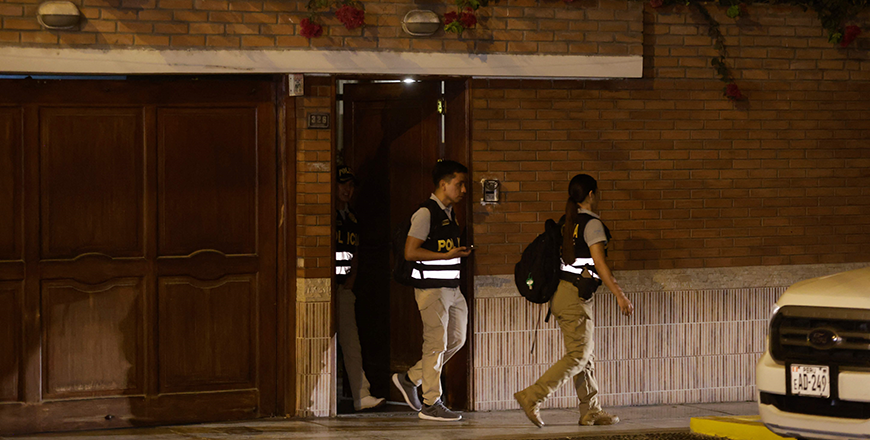You are here
Peru ends Lima curfew aimed at quelling protests
By AFP - Apr 06,2022 - Last updated at Apr 06,2022

Riot police protect themselves from tear gas thrown back by demonstrators during a protest against the governement of Peru’s President Pedro Castillo, in Lima, on Tuesday (AFP photo)
LIMA — Peruvian President Pedro Castillo on Tuesday announced the end of a curfew in the capital Lima aimed at containing protests against rising fuel prices following crisis talks with Congress.
“We will with immediate effect remove this immobility [curfew]. We call on the Peruvian people to be calm,” said the leftist leader, alongside Congress President Maria del Carmen Alva.
Police and soldiers patrolled the largely empty streets of the capital earlier on Tuesday after Castillo announced the curfew shortly before midnight on Monday for Lima and the neighbouring port city of Callao.
It was due to last until midnight on Tuesday as authorities attempted to curtail protests against rising fuel and toll prices amid growing economic hardship.
But news of the curfew’s end was met with cheers by hundreds of protesters outside Congress and in other parts of the capital, AFP journalists noted.
“The people did it!” said opposition legislator Alva on Twitter.
Shops and schools were closed and bus services mostly suspended but many workers, at hotels or hospitals for example, ignored the shut-down, which was widely criticised on social media.
The measure took many in Lima by surprise, given that the most violent protests in recent days took place far from the capital.
Many had no choice but to take a taxi or walk to their place of work.
“It was a very late and improvised” announcement, complained Cinthya Rojas, a nutritionist who waited patiently for one of the handful of buses still running to get to work at a hospital east of Lima.
A hotel employee told AFP she had to pay the equivalent of $8, a small fortune on her salary, for a taxi to work.
Some tourists had difficulty finding food, with restaurants and supermarkets closed, but domestic and international flights continued as normal from Jorge Chavez airport, its concessioner said.
Residents of some Lima neighbourhoods beat pots and pans at their windows in protest against the lockdown at noon.
Soaring food prices
“The measures taken, like those taken yesterday, are not against the people but in order to save the lives of compatriots,” said Castillo, balked by the first social protests of his eight-month-old presidency.
He had said the curfew move was “to reestablish peace” after countrywide protests amidst biting food inflation.
“There was information from a source that there were going to be acts of vandalism today. That is why we have taken this step,” Defence Minister Jose Gavidia said earlier on Tuesday.
While Lima was under curfew, protests continued and roads were blocked in several smaller cities elsewhere in Peru.
Like much of the rest of the world, Peru’s economy is reeling from the damages wrought by the coronavirus pandemic.
The country’s Consumer Price Index in March saw its highest monthly increase in 26 years, driven by soaring food, transport and education prices, according to the national statistics institute.
In an attempt to appease protesters, the government over the weekend eliminated the fuel tax and decreed a 10 per cent increase in the minimum wage from May 1.
But the General Confederation of Workers of Peru — the country’s main trade union federation — considered the measures insufficient and took to the streets again on Monday in Lima and several regions in Peru’s north.
Some protesters set fire to toll booths on highways, looted shops and clashed with police.
Others burned tires and blocked the north-south Pan-American highway, the country’s most important artery for people and goods.
The disruptions halted public transport and closed schools on Monday.
“Social protest is a constitutional right, but it must be done within the law,” Castillo, a 52-year-old former rural school teacher, pleaded during his brief TV appearance late on Monday.
‘Authoritarian measure’
Two-thirds of Peruvians disapprove of Castillo’s rule, according to an Ipsos opinion poll in March.
Castillo’s announcement of a curfew came a week after he escaped impeachment by Congress, where opponents accuse his administration of a “lack of direction” and of allowing corruption in his entourage.
It also coincided with the 30th anniversary of a coup staged by ex-president Alberto Fujimori, jailed over his regime’s bloody campaign against insurgents.
“The measure dictated by President Pedro Castillo is openly unconstitutional, disproportionate and violates people’s right to individual freedom,” tweeted lawyer Carlos Rivera, a representative of Fujimori’s victims.
Political analyst Luis Benavente told AFP the curfew was “an authoritarian measure” that revealed “ineptitude, incapacity to govern”.
A large proportion of Lima’s 10 million residents work in the informal sector, as street sellers and other traders, meaning the curfew left them without income for the day.
A Copa Libertadores football match between Peruvian Club Sporting Cristal and Brazil’s Flamengo, which had been thrown into doubt, would go ahead as scheduled on Tuesday night in Lima, regional governing body CONMEBOL said on Instagram.
Related Articles
LIMA — Peru closed the Inca citadel of Machu Picchu on Saturday amid steady anti-government protests, stranding hundreds of tourists for hou
LIMA — Ollanta Humala on Monday became the first ex-president of Peru to go on trial in a vast corruption case involving Brazilian construct
LIMA — Peruvian authorities raided President Dina Boluarte’s home and the government palace early Saturday as part of an ongoing corruption












